 The following article is the second part of a three-part list of films featuring serial killers. I’ve deliberately avoided movies concerning ‘spree killers’, ‘obsessed fans’, and movies that contain supernatural elements. It is not intended to be a complete list nor terribly insightful, but a simple rundown of the best, worst and most interesting serial killer titles to be found, and I thank both Wikipedia and the Internet Movie Database for assisting my research. I will gladly respond as soon as possible to any comments, questions and suggestions readers may have.
The following article is the second part of a three-part list of films featuring serial killers. I’ve deliberately avoided movies concerning ‘spree killers’, ‘obsessed fans’, and movies that contain supernatural elements. It is not intended to be a complete list nor terribly insightful, but a simple rundown of the best, worst and most interesting serial killer titles to be found, and I thank both Wikipedia and the Internet Movie Database for assisting my research. I will gladly respond as soon as possible to any comments, questions and suggestions readers may have.
also Check out:
Vintage Screams: Serial Killer Movies A-E
Vintage Screams: Serial Killer Movies P-Z
 FEAR OF CLOWNS (2004), written and directed by Kevin Kangas, focuses on an artist (Jacqueline Reres) who suffers from coulrophobia, a fear of clowns. She paints clowns as a type of therapy, until she finds herself being stalked by an evil clown by the name of Shivers, who resembles one of her paintings. The film proved popular enough on DVD to warrant a sequel a few years later entitled FEAR OF CLOWNS II (2007) by the same director.
FEAR OF CLOWNS (2004), written and directed by Kevin Kangas, focuses on an artist (Jacqueline Reres) who suffers from coulrophobia, a fear of clowns. She paints clowns as a type of therapy, until she finds herself being stalked by an evil clown by the name of Shivers, who resembles one of her paintings. The film proved popular enough on DVD to warrant a sequel a few years later entitled FEAR OF CLOWNS II (2007) by the same director.
THE FORGOTTEN (1973), directed by S.F. Brownrigg, was a very low budget filmed that was retitled DON’T LOOK IN THE BASEMENT and received a wide release due to being on a double-bill with THE LAST HOUSE ON THE LEFT (1973). Nurse Charlotte (Rosie Holotik) arrives to work at the isolated Stephens Sanitarium, only to learn that Doctor Stephens (Michael Harvey) was murdered by one of the patients and his successor, Doctor Masters (Annabelle Weenick), is not interested in hiring new staff. Charlotte insists, but finds the job hard as the patients torment and harass her at every turn, She soon learns why Doctor Masters is so eager to keep away outsiders.
 FRAILTY (2002), directed by and starring Bill Paxton as Dad, a genuinely nice single father who balances his life between a humble mechanic’s job and teaching his two sons a decent way of life. One evening a vision of the Almighty visits the God-fearing father, instructing him and his family to rid the world of demons prior to Judgment Day. The catch is that the demons look just like humans, and he can’t tell anyone about his new ‘job’ or else die. Dad is soon bringing home ‘demons’ and the boys are forced to watch and participate in the bloodletting.
FRAILTY (2002), directed by and starring Bill Paxton as Dad, a genuinely nice single father who balances his life between a humble mechanic’s job and teaching his two sons a decent way of life. One evening a vision of the Almighty visits the God-fearing father, instructing him and his family to rid the world of demons prior to Judgment Day. The catch is that the demons look just like humans, and he can’t tell anyone about his new ‘job’ or else die. Dad is soon bringing home ‘demons’ and the boys are forced to watch and participate in the bloodletting.
FRENZY (1972), directed by maestro Alfred Hitchcock, harks back to many other Hitchcock films, including THE LODGER (1927). The shock opening, for instance, is similar to the 1927 film in which the population of London is disquieted by the presence of an unknown strangler of blondes, dramatised by the appearance of a floating nude body during a riverside ceremony. The ‘Necktie Killer’ (Barry Foster) is a thoroughly unpleasant psychotic homosexual which to some extent forces sympathy against him, but the best performances are to be found amongst the supporting players: Alec McCowan, Vivien Merchant, and lovely Anna Massey.
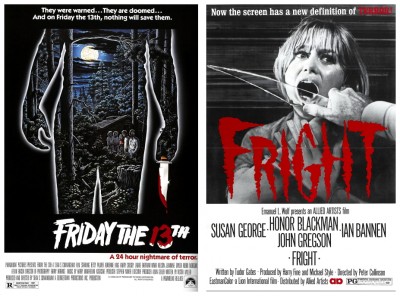 FRIDAY THE 13TH (1980), directed by Sean Cunningham, focuses on a group of young people who are murdered one-by-one while attempting to re-open a campsite that was closed years before after the death of a young camper named Jason Voorhees. The finale reveals the murders have been committed by Jason’s now mad mother (Betsy Palmer). Made for US$550,000 the film went on to become one of the most profitable serial killer films ever, spawning a long series of sequels, remakes, crossovers and spinoffs across the media spectrum. Unfortunately, the franchise has little to do with the original’s revenge story of a very mortal serial killer.
FRIDAY THE 13TH (1980), directed by Sean Cunningham, focuses on a group of young people who are murdered one-by-one while attempting to re-open a campsite that was closed years before after the death of a young camper named Jason Voorhees. The finale reveals the murders have been committed by Jason’s now mad mother (Betsy Palmer). Made for US$550,000 the film went on to become one of the most profitable serial killer films ever, spawning a long series of sequels, remakes, crossovers and spinoffs across the media spectrum. Unfortunately, the franchise has little to do with the original’s revenge story of a very mortal serial killer.
FRIGHT (1971), a British film directed by Peter Collinson, is considered a prototype in the slasher genre. Starring Susan George, Honor Blackman and Ian Bannen, the story involves a homicidal maniac who escapes from a mental asylum to terrorise a babysitter and her charge. Sound familiar? The real terror begins, however, when the child’s biological father appears after recently escaping from a nearby mental institution.
 FROM HELL (2001) is an adaptation of the graphic novel by Alan Moore and Eddie Campbell about the Jack The Ripper murders. Scotland Yard Inspector Abberline (Johnny Depp) is on the case to figure out who this serial killer is and why he is killing these women in such a brutal manner. Abberline becomes acquainted with the prostitutes who were friends and colleagues of the victims, and begins to fall in love with Mary Kelly (Heather Graham), one of the prostitutes being stalked by Jack The Ripper. Abberline digs deeper into the conspiracy and attempts to solve the case before Mary Kelly becomes the next victim. In this particular version of the Ripper case, the killer is revealed to be Sir William Gull (Ian Holm), a physician to the Royal Family.
FROM HELL (2001) is an adaptation of the graphic novel by Alan Moore and Eddie Campbell about the Jack The Ripper murders. Scotland Yard Inspector Abberline (Johnny Depp) is on the case to figure out who this serial killer is and why he is killing these women in such a brutal manner. Abberline becomes acquainted with the prostitutes who were friends and colleagues of the victims, and begins to fall in love with Mary Kelly (Heather Graham), one of the prostitutes being stalked by Jack The Ripper. Abberline digs deeper into the conspiracy and attempts to solve the case before Mary Kelly becomes the next victim. In this particular version of the Ripper case, the killer is revealed to be Sir William Gull (Ian Holm), a physician to the Royal Family.
THE FUNHOUSE (1981), directed by Tobe Hooper, focuses on four teenagers trapped in a carnival and stalked by a deformed killer named Gunther (Wayne Doba), the adopted son of carny barker Conrad (Kevin Conway). Conrad stalks the carnival to eliminate any witnesses and heckles Gunther into a murderous rage, using various ride props as murder weapons. The cast also includes William Finley, and two-time Oscar nominee Sylvia Miles.
 GIALLO (2009), directed by Dario Argento, follows flight attendant Linda (Emmanuelle Seigner) and detective Enzo (Adrien Brody), who team up to find Linda’s younger sister Celine, who has been abducted by a serial killer known only as Giallo (Italian for yellow). Giallo kidnaps women in his taxi, drugs them, mutilates them, eventually killing them, all the while taking photos. The film ends with Enzo and Giallo having a shootout in a hotel. Giallo tries to escape, but falls from a skylight to the floor of the lobby, killing him instantly.
GIALLO (2009), directed by Dario Argento, follows flight attendant Linda (Emmanuelle Seigner) and detective Enzo (Adrien Brody), who team up to find Linda’s younger sister Celine, who has been abducted by a serial killer known only as Giallo (Italian for yellow). Giallo kidnaps women in his taxi, drugs them, mutilates them, eventually killing them, all the while taking photos. The film ends with Enzo and Giallo having a shootout in a hotel. Giallo tries to escape, but falls from a skylight to the floor of the lobby, killing him instantly.
THE GIRL MOST LIKELY TO (1973), a made-for-television movie directed by Lee Philips, was a black comedy written by comedienne Joan Rivers that has since deservedly achieved a cult status, which is rare for a TV movie. Miriam Knight (Stockard Channing) is an intelligent but unattractive young woman who is disrespected by those around her. After she has her heart broken by a malicious jock, she is involved in an automobile accident, requiring reconstructive surgery. Once the bandages are removed, they reveal a brunette bombshell. She makes it her mission to exact vengeance on all those who did her wrong. An intelligent police detective (Ed Asner) figures out what she has done and why, arrests her, and finally the couple get married while she serves her sentence in prison.
 HACK! (2007), directed and written by Matt Flynn, features seven college students on a island field trip to study the wildlife, but it isn’t long before a serial killer begins murdering them one-by-one, each killing in the fashion of a famous horror movie. Featuring Danica McKellar, Juliet Landau, Kane Hodder, Burt Young, William Forsythe and Sean Kanan, there’s no shortage of suspects. Are the eccentric owners of the island the killers? Who is the mysterious fisherman lurking around the island? One of the students seems to know a lot more than she should.
HACK! (2007), directed and written by Matt Flynn, features seven college students on a island field trip to study the wildlife, but it isn’t long before a serial killer begins murdering them one-by-one, each killing in the fashion of a famous horror movie. Featuring Danica McKellar, Juliet Landau, Kane Hodder, Burt Young, William Forsythe and Sean Kanan, there’s no shortage of suspects. Are the eccentric owners of the island the killers? Who is the mysterious fisherman lurking around the island? One of the students seems to know a lot more than she should.
HATCHET (2006), written and directed by Adam Green, features an all-star horror film cast including Kane Hodder, Robert Englund, Tony Todd and John Carl Buechler. When a group of tourists on a New Orleans haunted swamp tour find themselves stranded in the wilderness, their evening of fun and spooks turns into a horrific nightmare when they learn the terrifying tale of a horribly disfigured man who was tragically killed with a hatchet by the hands of his own father. But when the boat sinks and the ghost story turns out to be real, the group tries desperately to escape the swamp with their lives.
 HE KNOWS YOU’RE ALONE (1980), directed by Armand Mastroianni, was one of the first horror films to be influenced by the success of HALLOWEEN (1978) and shares a number of similarities. A young bride is murdered on her wedding day by the man she rejected for her current fiancé Len (Lewis Arit), a police detective. Several years later the killer returns to murder a string of brides-to-be. Len believes the killer of his fiancè has returned and tracks the crimes. The killer stalks bride-to-be Amy (Caitlin O’Heaney), who is having second thoughts about her planned marriage, while her ex-boyfriend Marvin (Don Scardino) returns and tries to rekindle their relationship.
HE KNOWS YOU’RE ALONE (1980), directed by Armand Mastroianni, was one of the first horror films to be influenced by the success of HALLOWEEN (1978) and shares a number of similarities. A young bride is murdered on her wedding day by the man she rejected for her current fiancé Len (Lewis Arit), a police detective. Several years later the killer returns to murder a string of brides-to-be. Len believes the killer of his fiancè has returned and tracks the crimes. The killer stalks bride-to-be Amy (Caitlin O’Heaney), who is having second thoughts about her planned marriage, while her ex-boyfriend Marvin (Don Scardino) returns and tries to rekindle their relationship.
THE HEADLESS EYES (1971) was written and directed by Kent Beckman, the father of actors Jason and Justine Bateman. An artist named Arthur (Bo Brundin) who, desperately in need of rent money, sneaks into a woman’s bedroom and tries to steal the money off her nightstand. The woman pushes his eye out with a teaspoon and knocks him out the second-story window. After being gawked at with his eye dangling from his head and the ultimate loss of his eye, Arthur becomes a serial killer and uses his victims’ eyes in his artwork.
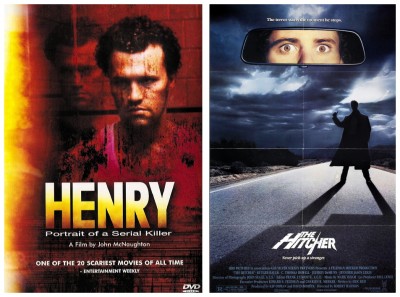 HENRY: PORTRAIT OF A SERIAL KILLER (1986), directed and written by John McNaughton, is loosely based on real-life serial killer Henry Lee Lucas. Henry (Michael Rooker) likes to kill people, in different ways each time. Henry shares an apartment with Otis (Tom Towles). When Otis’ sister (Tracy Arnold) comes to stay, we see both sides of Henry – the friendly ‘guy-next-door’ and the serial killer. The film was shot on 16mm film in less than a month with a relatively tiny budget of only US$110,000.
HENRY: PORTRAIT OF A SERIAL KILLER (1986), directed and written by John McNaughton, is loosely based on real-life serial killer Henry Lee Lucas. Henry (Michael Rooker) likes to kill people, in different ways each time. Henry shares an apartment with Otis (Tom Towles). When Otis’ sister (Tracy Arnold) comes to stay, we see both sides of Henry – the friendly ‘guy-next-door’ and the serial killer. The film was shot on 16mm film in less than a month with a relatively tiny budget of only US$110,000.
THE HITCHER (1986), directed by Robert Harmon, concerns a young man (C. Thomas Howell) transporting a car to another state who is stalked by a cunning and relentless serial killer John Ryder (Rutger Hauer), who eventually frames the driver for a string of murders. Chased by police and shadowed by the killer, the driver’s only help comes from a truck stop waitress (Jennifer Jason Lee). A remake was produced in 2007 by Michael Bay starring Sean Bean as serial killer John Ryder.
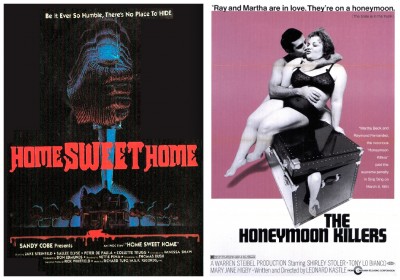 HOME SWEET HOME (1981) aka SLASHER IN THE HOUSE, directed by Nettie Pena, concerns an escaped homicidal serial killer (Jake Steinfeld) who steals a station wagon and makes his way to the Bradley family’s Thanksgiving celebration, where he plans to make them a little less thankful. One-by-one, the revelers are methodically stalked and served up in the butcher’s holiday blood feast. Before long, the Bradley’s home becomes a grisly house of horrors.
HOME SWEET HOME (1981) aka SLASHER IN THE HOUSE, directed by Nettie Pena, concerns an escaped homicidal serial killer (Jake Steinfeld) who steals a station wagon and makes his way to the Bradley family’s Thanksgiving celebration, where he plans to make them a little less thankful. One-by-one, the revelers are methodically stalked and served up in the butcher’s holiday blood feast. Before long, the Bradley’s home becomes a grisly house of horrors.
THE HONEYMOON KILLERS (1970), written and directed by Leonard Kastle, tells the story of Martha Beck (Shirley Stoler) and Raymond Fernandez (Tony Lo Bianco), the notorious ‘Lonely Hearts Killers’ who murdered at least twelve women during the forties. Ray is weedy, feral and untrustworthy, and Martha is overweight, compulsive and needy. Together, they play out a horrifying scheme in which Ray lures lonely women out on dates and proposes marriage to them, with Martha pretending to be his sister. They take the women’s savings and then murder them remorselessly. Dank, claustrophobic and weirdly engrossing, this movie never quite gives in to the comforts of conventional narrative. Famous French filmmaker Francois Truffaut named it as one of his favourite American films of all-time.
 HORROR HOSPITAL (1973) is a British horror-comedy written and directed by Antony Balch, in which failed pop star Jason Jones (Robin Askwith) gets away from it all by attending a health-farm called Brittlehurst Manor. The health-farm is actually a front for Doctor Storm (Michael Gough) and his lobotomised slaves, including erstwhile brothel madam Olga (Ellen Pollock), dwarf Frederick (Skip Martin) and numerous lobotomised thugs and bikies. Storm also has a Rolls Royce fitted with a giant blade that decapitates escapees and interfering parties. Frederick, tired of being Storm’s whipping boy, helps the kids to escape, putting an end to the doctor’s evil scheme.
HORROR HOSPITAL (1973) is a British horror-comedy written and directed by Antony Balch, in which failed pop star Jason Jones (Robin Askwith) gets away from it all by attending a health-farm called Brittlehurst Manor. The health-farm is actually a front for Doctor Storm (Michael Gough) and his lobotomised slaves, including erstwhile brothel madam Olga (Ellen Pollock), dwarf Frederick (Skip Martin) and numerous lobotomised thugs and bikies. Storm also has a Rolls Royce fitted with a giant blade that decapitates escapees and interfering parties. Frederick, tired of being Storm’s whipping boy, helps the kids to escape, putting an end to the doctor’s evil scheme.
HOSPITAL MASSACRE (1982), directed by Boaz Davidson, pits a former Playboy bunny against a sociopath who has been haunting her for two decades. Susan Jeremy was adored by all the boys at her school. When she rejects a boy named Harry for another named David, Harry kills David and runs away laughing maniacally. Nineteen years later, Mrs. Jeremy (Barbi Benton) seems to have forgotten all about the murder, but Harry (Charles Lucia) has not. When Susan is sent to her local hospital for a routine checkup, she discovers someone does not want her to leave. A masked killer disguised as a surgeon is stalking her and killing anyone who gets in his way.
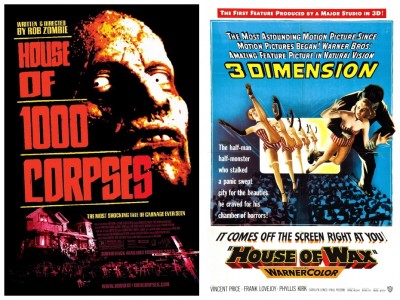 HOUSE OF 1000 CORPSES (2002), written and directed by Rob Zombie, was the rocker’s directorial debut, and concerns two couples on the road writing a book about offbeat roadside attractions. When they meet Captain Spaulding (Sid Haig), they learn of the local legend of Doctor Satan and, soon after, pick up a hitchhiker named Baby (Sheri Moon Zombie). When their car breaks down, Baby invites them into her house to meet the bizarre Firefly family, a murderous clan of killers. As the family attacks, the unsuspecting couples try to survive the so-called house of a thousand corpses and it’s dark secrets.
HOUSE OF 1000 CORPSES (2002), written and directed by Rob Zombie, was the rocker’s directorial debut, and concerns two couples on the road writing a book about offbeat roadside attractions. When they meet Captain Spaulding (Sid Haig), they learn of the local legend of Doctor Satan and, soon after, pick up a hitchhiker named Baby (Sheri Moon Zombie). When their car breaks down, Baby invites them into her house to meet the bizarre Firefly family, a murderous clan of killers. As the family attacks, the unsuspecting couples try to survive the so-called house of a thousand corpses and it’s dark secrets.
HOUSE OF WAX (1953), a 3-D remake of THE MYSTERY OF THE WAX MUSEUM (1933), was directed by one-eyed filmmaker Andre Toth and stars Vincent Price as the obsessed wax sculptor Henry Jarrod. His museum’s popular Chamber Of Horrors showcases famous crimes, including the murder of Jarrod’s former business partner by a cloaked, disfigured killer. Cathy (Carolyn Jones) is also killed, but when Cathy’s friend Sue (Phyllis Kirk) visits the museum, she discovers the horrifying truth behind the House Of Wax: all the sculptures are the wax-coated bodies of Jarrod’s victims. Sue herself almost becomes an exhibit as well but, luckily, it’s the disfigured Jarrod who falls into the boiling wax instead. The film was very loosely remade in 2005 by Jaume Collet-Serra starring Paris Hilton.
 THE HOUSE ON SORORITY ROW (1983), directed by Mark Rosman, concerns a group of girls staying at a sorority house with the house’s owner, who wants them out. They decide to play a prank on her, but it goes awry and she winds up dead. Panicking, the girls try to hide the body, but someone witnessed the crime and begins to stalk them.
THE HOUSE ON SORORITY ROW (1983), directed by Mark Rosman, concerns a group of girls staying at a sorority house with the house’s owner, who wants them out. They decide to play a prank on her, but it goes awry and she winds up dead. Panicking, the girls try to hide the body, but someone witnessed the crime and begins to stalk them.
I KNOW HOW MANY RUNS YOU SCORED LAST SUMMER (2008), written and directed by Doug Turner and Stacey Edmonds, is an Australian film in which a cricket team are dismissed by a moustachioed serial killer with a razor-sharp cricket glove and an arsenal of sharpened stumps. One-by-one the killer exacts revenge for the torment he endured twenty years earlier.
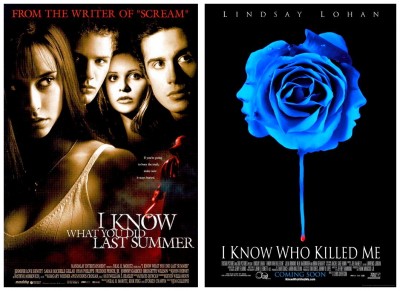 I KNOW WHAT YOU DID LAST SUMMER (1997), directed by Jim Gillespie, received negative reviews from critics, but was nevertheless highly successful, grossing US$125,500,000 primarily due to it’s cast: Sarah Michelle Gellar, Freddie Prinze Junior and Jennifer Love-Hewitt. As a result two sequels followed: I STILL KNOW WHAT YOU DID LAST SUMMER (1998) and I’LL ALWAYS KNOW WHAT YOU DID LAST SUMMER (2006). Four young friends in a car hit a pedestrian, apparently dead. They make a pact to keep it a secret but, while dumping the body in the sea, discover the pedestrian is not yet dead. They throw him in vowing never to return. One year later, one of the friends receives a letter stating ‘I know what you did last summer’. She gathers her old friends who are now separated, miserable and isolated. They decide to find out who saw them that fateful night and, in the process of tracking the suspect down, the body-count goes up.
I KNOW WHAT YOU DID LAST SUMMER (1997), directed by Jim Gillespie, received negative reviews from critics, but was nevertheless highly successful, grossing US$125,500,000 primarily due to it’s cast: Sarah Michelle Gellar, Freddie Prinze Junior and Jennifer Love-Hewitt. As a result two sequels followed: I STILL KNOW WHAT YOU DID LAST SUMMER (1998) and I’LL ALWAYS KNOW WHAT YOU DID LAST SUMMER (2006). Four young friends in a car hit a pedestrian, apparently dead. They make a pact to keep it a secret but, while dumping the body in the sea, discover the pedestrian is not yet dead. They throw him in vowing never to return. One year later, one of the friends receives a letter stating ‘I know what you did last summer’. She gathers her old friends who are now separated, miserable and isolated. They decide to find out who saw them that fateful night and, in the process of tracking the suspect down, the body-count goes up.
I KNOW WHO KILLED ME (2007), directed by Chris Sivertson, focuses on the quiet suburb of New Salem which is being terrorised by a serial killer who abducts and tortures young women, holding them captive for weeks before murdering them. Aubrey (Lindsay Lohan), a pianist and aspiring writer, appears to be his latest victim when she disappears during a night out with her friends. As the days tick by, the special FBI Task Force convened to track the killer begin to lose hope of finding her before it’s too late.
 IDENTITY (2003), directed by James Mangold, is perhaps the most recent direct adaptation of the seminal Agatha Christie novel AND THEN THERE WERE NONE, starring John Cusack, Ray Liotta, Jake Busey, Rebecca De Mornay and Alfred Molina. Strangers from all different walks of life are caught in a rainstorm and stuck at a motel in desolate Nevada. Soon they realise they may be at the motel for another reason when, one-by-one, people are getting killed. Meanwhile, in an undisclosed location, a psychiatrist is trying to prove the innocence of a man accused of murder in a trial.
IDENTITY (2003), directed by James Mangold, is perhaps the most recent direct adaptation of the seminal Agatha Christie novel AND THEN THERE WERE NONE, starring John Cusack, Ray Liotta, Jake Busey, Rebecca De Mornay and Alfred Molina. Strangers from all different walks of life are caught in a rainstorm and stuck at a motel in desolate Nevada. Soon they realise they may be at the motel for another reason when, one-by-one, people are getting killed. Meanwhile, in an undisclosed location, a psychiatrist is trying to prove the innocence of a man accused of murder in a trial.
IN THE LIGHT OF THE MOON (2000) aka ED GEIN, directed by Chuck Parello, is a low budget film that recounts the crimes of real-life serial killer Ed Gein (Steve Railsback), who digs up the corpses of more than a dozen women and made bizarre objects out of their remains before finally shooting two people to death and butchering their bodies. The film also portrays Gein’s tormented youth, his relationship with his adored but domineering mother, and the 1957 arrest that uncovered the bizarre series of murders.
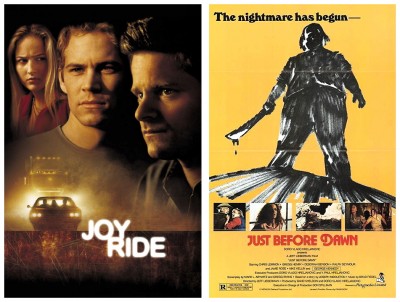 JOY RIDE (2001) aka ROAD KILL, directed by John Dahl and written by J.J. Abrams, was heavily inspired by Steven Spielberg’s DUEL (1971) with numerous references to that film: a menacing ICE truck pulls up to a gas station that the brothers have pulled up to; and the central antagonist remains entirely unseen until a brief shot near the conclusion of the film. Three young people on a road trip from Colorado to New Jersey talk to a trucker on their CB radio (voiced by Ted Levine), then must escape when he turns out to be a psychotic serial killer.
JOY RIDE (2001) aka ROAD KILL, directed by John Dahl and written by J.J. Abrams, was heavily inspired by Steven Spielberg’s DUEL (1971) with numerous references to that film: a menacing ICE truck pulls up to a gas station that the brothers have pulled up to; and the central antagonist remains entirely unseen until a brief shot near the conclusion of the film. Three young people on a road trip from Colorado to New Jersey talk to a trucker on their CB radio (voiced by Ted Levine), then must escape when he turns out to be a psychotic serial killer.
JUST BEFORE DAWN (1981), directed by Jeff Lieberman and inspired by DELIVERANCE (1972), has developed a devoted following among horror fans, praised for its eerie atmosphere, lush cinematography, and above-average cast. Unlike many films of its kind, it focuses more on suspense instead of gruesome violence. Five campers arrive in the mountains to examine a property they have bought, but are warned by the forest ranger that a huge machete-wielding maniac has been terrorising the area. Ignoring the warnings, they set-up camp and promptly start disappearing one-by-one.
 KILLER’S MOON (1978), written and directed by Alan Birkinshaw with dialogue by Fay Weldon, involves a bus full of schoolgirls which breaks down, forcing the girls to take shelter for the night in a remote hotel. Meanwhile, strange and macabre things are happening to the locals and it is soon revealed that four escaped mental patients, dosed up with LSD as part of their treatment, are roaming the area. They are convinced they are living a shared dream in which they are free to rape and murder, which they do numerous times before the belated arrival of the police.
KILLER’S MOON (1978), written and directed by Alan Birkinshaw with dialogue by Fay Weldon, involves a bus full of schoolgirls which breaks down, forcing the girls to take shelter for the night in a remote hotel. Meanwhile, strange and macabre things are happening to the locals and it is soon revealed that four escaped mental patients, dosed up with LSD as part of their treatment, are roaming the area. They are convinced they are living a shared dream in which they are free to rape and murder, which they do numerous times before the belated arrival of the police.
KIND HEARTS AND CORONETS (1949), directed by Robert Hamer, is a highly regarded British black comedy loosely based on the Roy Horniman novel The Autobiography Of A Criminal, and is famous for featuring Alec Guinness in eight separate roles. Dennis Price plays a distant poor relative of the Duke of D’Ascoyne who plots to inherit the title by murdering the eight other heirs who stand ahead of him in the line of succession.
 KNIGHT MOVES (1992), directed by Carl Schenkel, focuses on a chess grandmaster (Christopher Lambert) who is accused of several grisly murders that seem to have been committed by a childhood rival who has spent the last two decades in asylums and foster care. When more homicides occur Captain Sedman and his partner Detective Wagner discover that a serial killer is at work. With our chessmaster becoming more and more connected to the deaths, a psychiatrist is brought in to figure out if this chess prodigy is as innocent as he claims to be.
KNIGHT MOVES (1992), directed by Carl Schenkel, focuses on a chess grandmaster (Christopher Lambert) who is accused of several grisly murders that seem to have been committed by a childhood rival who has spent the last two decades in asylums and foster care. When more homicides occur Captain Sedman and his partner Detective Wagner discover that a serial killer is at work. With our chessmaster becoming more and more connected to the deaths, a psychiatrist is brought in to figure out if this chess prodigy is as innocent as he claims to be.
THE LODGER (1927), directed by maestro Alfred Hitchcock, was adapted by Eliot Stannard from a rather brilliant novel by Marie Belloc-Lowndes with a ‘Jack The Ripper’ theme, in which an unknown murderer is at large eliminating blondes. To a Bloomsbury boarding house comes a mysterious young man who keeps to himself and paces the floor despairingly before gliding out of the house on nocturnal sorties. Inevitably he is suspected, arrested and almost lynched before his innocence is established by the red-handed capture of the real serial killer.
 LOVERS LANE (2000), directed by Jon Steven Ward, is an extended variation on the urban legend known as ‘The Hook’. Thirteen years ago, on Valentine’s Day at the local lovers lane, Dee-Dee (Diedre Kilgore) and Jimmy (Carter Roy) are making out in their car when a maniac wielding a steel hook attacks them. The pair escape the car and find another couple, Harriet and Ward, slaughtered in the car next to theirs. Thirteen years later the homicidal maniac returns to kill his victim’s children.
LOVERS LANE (2000), directed by Jon Steven Ward, is an extended variation on the urban legend known as ‘The Hook’. Thirteen years ago, on Valentine’s Day at the local lovers lane, Dee-Dee (Diedre Kilgore) and Jimmy (Carter Roy) are making out in their car when a maniac wielding a steel hook attacks them. The pair escape the car and find another couple, Harriet and Ward, slaughtered in the car next to theirs. Thirteen years later the homicidal maniac returns to kill his victim’s children.
M (1931) aka Eine Stadt Sucht Einen Mörder, directed by Fritz Lang, is considered by many to be the first ‘serial killer’ movie, involving police procedurals and even a glimpse into the sadly maddened killer himself, a victim of his own diseased mind. Loosely inspired by the real-life crimes of Peter Kurten of Dusseldorf, Peter Lorre plays a serial killer of young children. When the police in a German city are unable to catch the child-murderer, the local crime syndicates join in the manhunt, and succeed in tracking down the killer.
 MALEVOLENCE (2005), directed by Stevan Mena, is about a woman and her daughter who have been kidnapped by bank robbers who have decided to hide out during the night in a house in the middle of nowhere. The daughter manages to escape only to find herself in another house, except this one is owned by a serial killing psychopath. This puts herself, her mother and the robbers in mortal danger.
MALEVOLENCE (2005), directed by Stevan Mena, is about a woman and her daughter who have been kidnapped by bank robbers who have decided to hide out during the night in a house in the middle of nowhere. The daughter manages to escape only to find herself in another house, except this one is owned by a serial killing psychopath. This puts herself, her mother and the robbers in mortal danger.
MAN BITES DOG (1992) is a Belgian black comedy mockumentary directed by a trio of filmmakers, in which a camera crew follows a serial killer around as he exercises his craft. He expounds on art, music, nature, society and life as he disposes of random people. Slowly he begins involving the camera crew in his activities, and they begin wondering if what they’re doing is such a good idea, particularly when the killer murders a rival and and then receives a threatening letter from the rival’s brother. Who ever said the Belgians don’t have a sense of humour?
 MANHUNTER (1986), written and directed by Michael Mann, is based on the best-selling Thomas Harris novel Red Dragon, and was the first film appearance of horror icon Hannibal ‘The Cannibal’ Lecter as played by a bare-faced Brian Cox. FBI agent Will Graham (William Petersen) is called out of retirement to investigate a serial killer known as The Tooth Fairy (Tom Noonan) but, to do so, he must confront the imprisoned murderer who almost succeeded in killing Graham: Doctor Lecter. The character as played by Anthony Hopkins would later appear in THE SILENCE OF THE LAMBS (1991), HANNIBAL (2001) and the remake of Manhunter, RED DRAGON (2002).
MANHUNTER (1986), written and directed by Michael Mann, is based on the best-selling Thomas Harris novel Red Dragon, and was the first film appearance of horror icon Hannibal ‘The Cannibal’ Lecter as played by a bare-faced Brian Cox. FBI agent Will Graham (William Petersen) is called out of retirement to investigate a serial killer known as The Tooth Fairy (Tom Noonan) but, to do so, he must confront the imprisoned murderer who almost succeeded in killing Graham: Doctor Lecter. The character as played by Anthony Hopkins would later appear in THE SILENCE OF THE LAMBS (1991), HANNIBAL (2001) and the remake of Manhunter, RED DRAGON (2002).
MANIAC (1980), directed by William Lustig and written by lead actor Joe Spinell, focuses on a disturbed serial killer traumatised by childhood abuse, who is stalking New York women and taking their scalps as trophies. A young photographer named Anna (Caroline Munro) becomes his next target, the ‘perfect woman’ who would represent the end of the maniac’s killings. The low-budget film is notable for its extremely graphic effects by Tom Savini (who is also amongst the cast as Disco Boy), but it is primarily a character study anticipating the far superior HENRY: PORTRAIT OF A SERIAL KILLER (1986).
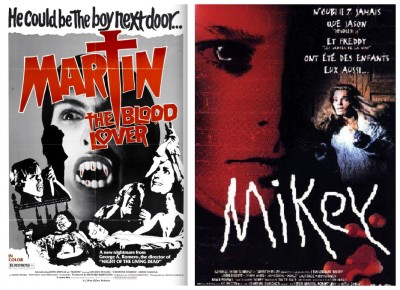 MARTIN (1977) directed by George Romero, begins with a conventional but extremely vivid horror sequence of a teenage boy in a train attacking a woman in a sleeping compartment, drugging her, then cutting her arm to drink her blood. It looks, in short, like the nastiest kind of sadistic exploitation movie, but it does not continue that way. Martin (John Amplas), who is obviously mentally ill, believes he is a vampire and suffers hallucinations in which he envisages his vampiric behaviour romantically, very much in the style of old B-grade movies. There may be a chance that his severe disturbance may cure itself – it is clearly connected with feelings of sexual inadequacy, and his sexual initiation by a local bored housewife seems to free him of his obsession.
MARTIN (1977) directed by George Romero, begins with a conventional but extremely vivid horror sequence of a teenage boy in a train attacking a woman in a sleeping compartment, drugging her, then cutting her arm to drink her blood. It looks, in short, like the nastiest kind of sadistic exploitation movie, but it does not continue that way. Martin (John Amplas), who is obviously mentally ill, believes he is a vampire and suffers hallucinations in which he envisages his vampiric behaviour romantically, very much in the style of old B-grade movies. There may be a chance that his severe disturbance may cure itself – it is clearly connected with feelings of sexual inadequacy, and his sexual initiation by a local bored housewife seems to free him of his obsession.
MIKEY (1992), directed by Dennis Dimster, centres on Mikey Holt (Brian Bonsall), a young boy who is adopted by a family after his previous adoptive family dies. Instead of the darling child they expected, Mikey turns out to be a violent sociopath and serial killer. It is discovered that every family Mikey has lived with before have met with a series of unexplained fatal accidents.
 THE MINUS MAN (1999), written and directed by Hampton Fancher, is based on the novel by Lew McCreary and centres on a cold-blooded serial killer (Owen Wilson) who roams the country in search of potential victims that complain about their lives and indicate a willingness to leave this mortal coil. Director Fancher described the character as being a cross between Norman Bates of PSYCHO (1960) and Chauncey Gardner of BEING THERE (1979).
THE MINUS MAN (1999), written and directed by Hampton Fancher, is based on the novel by Lew McCreary and centres on a cold-blooded serial killer (Owen Wilson) who roams the country in search of potential victims that complain about their lives and indicate a willingness to leave this mortal coil. Director Fancher described the character as being a cross between Norman Bates of PSYCHO (1960) and Chauncey Gardner of BEING THERE (1979).
MISTER BROOKS (2007), directed by Bruce A. Evans, follows a celebrated Portland businessman and serial killer known as Mister Brooks (Kevin Costner) who needs to take on an apprentice (Dane Cook) after being blackmailed. Brooks also has to contend with his own evil subconscious (William Hurt) who forces him to indulge his habit. His life becomes even more complex when a police officer (Demi Moore) reopens the investigation into the series of murders.
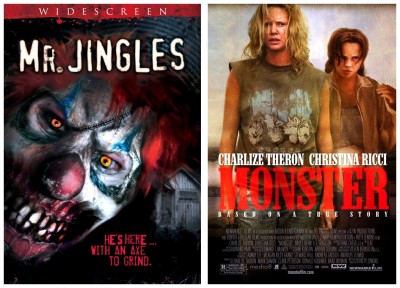 MISTER JINGLES (2006), written and directed by Todd and Tommy Brunswick, concerns an innocent man imprisoned for a crime he didn’t commit. He suffers for many years in prison and eventually escapes to take his revenge on the guilty, killing four families in one night while dressed as a clown. One traumatised girl by the name of Angie (Kelli Jensen) becomes a ward of the state mental hospital. Fast forward seven years when Angie returns home, but there’s a certain someone who’s been waiting a very long time to finish what he’d started.
MISTER JINGLES (2006), written and directed by Todd and Tommy Brunswick, concerns an innocent man imprisoned for a crime he didn’t commit. He suffers for many years in prison and eventually escapes to take his revenge on the guilty, killing four families in one night while dressed as a clown. One traumatised girl by the name of Angie (Kelli Jensen) becomes a ward of the state mental hospital. Fast forward seven years when Angie returns home, but there’s a certain someone who’s been waiting a very long time to finish what he’d started.
MONSTER (2003), written and directed by Patty Jenkins, is based on the real-life serial killer Aileen Wuornos (Charlize Theron) who murdered seven men over nine months from 1989 to 1990. Aileen is a prostitute in a lesbian relationship who begins murdering her clientele in order to get money without using sex. Theron won seventeen major ‘Best Actress’ awards for her portrayal, including the Oscar, the Golden Globe, and the Screen Actors Guild.
 MOONSTALKER (1989), written and directed by Michael O’Rourke, is a low budget independent film about a family of vacationers who meet a disheveled man named Pop (Tom Hamil) driving an old car towing a caravan. He tells a tale about the death of his son Bernie (Blake Gibbons) but, in actuality, his son is a homicidal maniac who Pop keeps chained up in the caravan. Needless to say, Bernie doesn’t stay chained up for long, and soon goes on a murderous rampage terrorising the local wilderness campers.
MOONSTALKER (1989), written and directed by Michael O’Rourke, is a low budget independent film about a family of vacationers who meet a disheveled man named Pop (Tom Hamil) driving an old car towing a caravan. He tells a tale about the death of his son Bernie (Blake Gibbons) but, in actuality, his son is a homicidal maniac who Pop keeps chained up in the caravan. Needless to say, Bernie doesn’t stay chained up for long, and soon goes on a murderous rampage terrorising the local wilderness campers.
MOTEL HELL (1980), directed by Kevin Connor and starring Rory Calhoun as a farmer and butcher of selective meats, is a satire of contemporary horror films from PSYCHO (1960) to THE LAST HOUSE ON THE LEFT (1972) to THE TEXAS CHAINSAW MASSACRE (1974). Farmer Vincent kidnaps unsuspecting travelers and buries them neck-deep in his garden. Unfortunately for his victims, they are not dead. He feeds his victims to prepare them for his roadside stand. His motto is ‘It Takes All Kinds Of Critters To Make Farmer Vincent’s Fritters’. Because of its low budget nature, the original intent was to make a serious horror film with moments of disturbing wit and irony and, on the whole, succeeds.
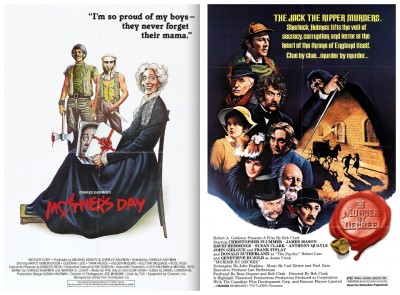 MOTHER’S DAY (1980), produced and directed by brothers Charles and Lloyd Kaufman, is amongst the first and most successful of the Troma Entertainment catalogue. Three women who were friends in college get together for a reunion and decide to go camping in the woods. Unbeknown to them, two boys and thier mother who happen to live in those very same woods, like to abduct anyone who happens to wander into their neck of the woods and torture them, just like they’ve seen on television. A remake directed by Darren Lynn Bousman and produced by Brett Ratner was released in 2010.
MOTHER’S DAY (1980), produced and directed by brothers Charles and Lloyd Kaufman, is amongst the first and most successful of the Troma Entertainment catalogue. Three women who were friends in college get together for a reunion and decide to go camping in the woods. Unbeknown to them, two boys and thier mother who happen to live in those very same woods, like to abduct anyone who happens to wander into their neck of the woods and torture them, just like they’ve seen on television. A remake directed by Darren Lynn Bousman and produced by Brett Ratner was released in 2010.
MURDER BY DECREE (1979), directed by Bob Clark, is yet another version of the Jack The Ripper killings with a twist. Sherlock Holmes (Christopher Plummer) and Doctor Watson (James Mason) are on the case. Holmes finds that the murders may have its roots in a Royal indiscretion and that a cover-up is being managed by politicians at the highest level, all of whom happen to be Masons. Holmes races to save the life of Annie (Genevieve Bujold) who has been forcibly incarcerated in an insane asylum and that of her friend Mary Kelly (Susan Clark), with whom she has entrusted her secret. The film is loosely based on the Stephen Knight novel Jack The Ripper: The Final Solution.
 MY BLOODY VALENTINE (1981), directed by George Mihalka, was one of many films to jump on the ‘holiday’ bandwagon following the success of HALLOWEEN (1978) and FRIDAY THE 13TH (1980). An explosion of methane gas takes the lives of a group of coal miners near the small town of Valentine Bluffs. The accident occurred because supervisors left their posts to attend the annual Valentine Day dance. One year later, the only survivor of the accident retaliates by killing the two supervisors, and warns to never hold another Valentine Day dance. Exactly twenty years later, a group of young people hold another dance in the local coal mine, and it isn’t long before the members of the group begin dying violently. The 2009 uncut DVD release proved so popular a remake was produced in 3-D the same year.
MY BLOODY VALENTINE (1981), directed by George Mihalka, was one of many films to jump on the ‘holiday’ bandwagon following the success of HALLOWEEN (1978) and FRIDAY THE 13TH (1980). An explosion of methane gas takes the lives of a group of coal miners near the small town of Valentine Bluffs. The accident occurred because supervisors left their posts to attend the annual Valentine Day dance. One year later, the only survivor of the accident retaliates by killing the two supervisors, and warns to never hold another Valentine Day dance. Exactly twenty years later, a group of young people hold another dance in the local coal mine, and it isn’t long before the members of the group begin dying violently. The 2009 uncut DVD release proved so popular a remake was produced in 3-D the same year.
THE MYSTERY OF THE WAX MUSEUM (1933), directed by Michael Curtiz, begins in London where wax sculptor Ivan Igor (Lionel Atwill) struggles to prevent his partner from burning down his museum. Many years later, Igor starts a new museum in New York, and takes a sinister interest in Charlotte (Fay Wray) and arouses the suspicions of Charlotte’s wisecracking roommate Florence (Glenda Farrell). In an inevitably ironic twist, into the cauldron of boiling wax goes the evil Ivan Igor. It was effectively remade in 3-D as HOUSE OF WAX (1953) with Vincent Price, and that’s where they should have stopped. The 2005 version had more in common with THE TEXAS CHAINSAW MASSACRE (1974), and it’s only real redeeming feature is the demise of actress (I use the term loosely here) Paris Hilton.
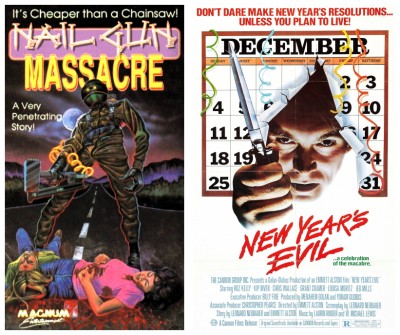 THE NAIL GUN MASSACRE (1985), directed by Terry Lofton and Bill Leslie, follows a young doctor and sheriff as they try to find a killer wearing a motorcycle helmet who is murdering locals with a nail gun. A young woman (Michelle Meyer) is gang-raped by a group of construction workers then, five months later, someone dresses up in army fatigues and a motorcycle helmet, and sets out on a bloody rampage for revenge. While many townspeople are being killed, the local doctor and sheriff set out to find the murderer and unmask him once and for all. After a short chase, the killer suffers a fatal fall on a construction site. The helmet comes off, revealing it to be Bubba (Beau Leland), the brother of the rape victim.
THE NAIL GUN MASSACRE (1985), directed by Terry Lofton and Bill Leslie, follows a young doctor and sheriff as they try to find a killer wearing a motorcycle helmet who is murdering locals with a nail gun. A young woman (Michelle Meyer) is gang-raped by a group of construction workers then, five months later, someone dresses up in army fatigues and a motorcycle helmet, and sets out on a bloody rampage for revenge. While many townspeople are being killed, the local doctor and sheriff set out to find the murderer and unmask him once and for all. After a short chase, the killer suffers a fatal fall on a construction site. The helmet comes off, revealing it to be Bubba (Beau Leland), the brother of the rape victim.
NEW YEAR’S EVIL (1980), directed by Emmett Alston, begins on New Year’s Eve while punk veejay Blaze (Roz Kelly) is holding a late-night countdown celebration of music and partying. All is going well until Blaze receives a phone call from an odd sounding stranger claiming his name is Evil, who announces on live television that when the clock strikes twelve in each time zone, a ‘Naughty Girl’ will be murdered, then the killer signs off with a threat claiming that Blaze will be the last one to die. The killer records his victims as he murders them and calls back the station each time playing the tapes back to prove he’s serious. There are many suspects as to who the mysterious killer is: a crazed fan; a religious psychotic; or maybe it’s someone much closer to Blaze than anyone could have ever expected.
 THE NEW YORK RIPPER (1982), directed by Lucio Fulci, is a prime example of the Giallo of Italian horror movies, a genre known for its graphic violence, explicit gore and sexuality. A serial killer – who sounds like a bit like a duck – wanders around New York City killing women by various means including slicing an eyeball with a razor-blade. A burned-out New York police detective teams up with a college psychoanalyst to track down the vicious serial killer randomly stalking and killing various young women around the city.
THE NEW YORK RIPPER (1982), directed by Lucio Fulci, is a prime example of the Giallo of Italian horror movies, a genre known for its graphic violence, explicit gore and sexuality. A serial killer – who sounds like a bit like a duck – wanders around New York City killing women by various means including slicing an eyeball with a razor-blade. A burned-out New York police detective teams up with a college psychoanalyst to track down the vicious serial killer randomly stalking and killing various young women around the city.
THE NIGHT BRINGS CHARLIE (1990), directed by Tom Logan on a very low budget, is notable for the antagonist’s somewhat unique mask, consisting of a burlap sack and goggles. In the small town of Pakoe, the body of a teenager is discovered with its head sawn-off. As more victims turn up, the police organise neighbourhood patrols in an effort to prevent further deaths. Meanwhile, tree surgeon Charlie Puckett returns home after surviving a freak accident involving a chainsaw that has left him facially disfigured and somewhat brain damaged. Charlie hides his disfigured face with a potato sack complete with goggles. He soon becomes a prime suspect in the murders due to his unsteady mental state and arsenal of tree-trimming implements.
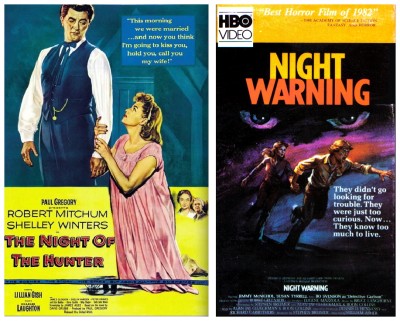 THE NIGHT OF THE HUNTER (1955), directed by actor Charles Laughton and starring Robert Mitchum and Shelley Winters, is based on the novel by Davis Grubb which, in turn, was inspired by the real-life story of serial killer Harry Powers, hanged in 1932 for the murders of two widows and three children in West Virginia. The film’s lyrical and expressionistic style sets it apart from other Hollywood films of the era and has influenced many other filmmakers since, including David Lynch, Martin Scorsese, Terrence Malick, Jim Jarmusch, Rob Zombie and Spike Lee. It is one of the few films in this list to be deemed culturally, historically or aesthetically significant by the United States Library Of Congress and was selected for preservation in the National Film Registry.
THE NIGHT OF THE HUNTER (1955), directed by actor Charles Laughton and starring Robert Mitchum and Shelley Winters, is based on the novel by Davis Grubb which, in turn, was inspired by the real-life story of serial killer Harry Powers, hanged in 1932 for the murders of two widows and three children in West Virginia. The film’s lyrical and expressionistic style sets it apart from other Hollywood films of the era and has influenced many other filmmakers since, including David Lynch, Martin Scorsese, Terrence Malick, Jim Jarmusch, Rob Zombie and Spike Lee. It is one of the few films in this list to be deemed culturally, historically or aesthetically significant by the United States Library Of Congress and was selected for preservation in the National Film Registry.
NIGHT WARNING (1982) aka BUTCHER BAKER NIGHTMARE MAKER, directed by William Asher, is an above-average exploitation film nominated for a Saturn Award for Best Horror Movie whose subject matter deals with homophobia and incest in a classical Oedipus-style tale. A homophobic police detective (Bo Svenson) tries to frame a high-school basketball player (Jimmy MacNichol) for the murder of a television repairman when he becomes convinced that the killing was the result of a homosexual love triangle. Unknown to the detective, Billy’s aunt Cheryl (Susan Tyrrell) is the real killer – having harboured incestuous fantasies towards Billy for years, his impending graduation has caused long dormant homicidal urges to resurface. Joe’s continued harassment of Billy causes Cheryl to become progressively more unstable, ultimately jeopardising the lives of everyone around her.
 NIGHTWATCH (1997), directed by Ole Bornedal and starring Ewan McGregor, Patricia Arquette, Josh Brolin and Nick Nolte, is a remake of the Danish film NATTEVAGTEN (1994), also directed by Bornedal. Martin is a law school student who takes a job as a night watchman at a morgue. When a necrophiliac serial killer begins plaguing the city, Martin finds himself the target of the madman’s wrath.
NIGHTWATCH (1997), directed by Ole Bornedal and starring Ewan McGregor, Patricia Arquette, Josh Brolin and Nick Nolte, is a remake of the Danish film NATTEVAGTEN (1994), also directed by Bornedal. Martin is a law school student who takes a job as a night watchman at a morgue. When a necrophiliac serial killer begins plaguing the city, Martin finds himself the target of the madman’s wrath.
ORPHAN (2009), directed by Jaume Collet-Serra, centres on a couple who, after the death of their unborn child, adopt a mysterious nine-year old girl named Esther (Isabelle Fuhrman). The parents call Sister Abigail at the orphanage, who informs them that Esther has had a troubled and mysterious history. Foster mother Kate delves further into Esther’s past to discover she is not at all who she pretends to be. The film received mixed critical reviews although Fuhrman’s performance as Esther was rightfully acclaimed.
 Horror News | HNN Official Site | Horror Movies,Trailers, Reviews
Horror News | HNN Official Site | Horror Movies,Trailers, Reviews




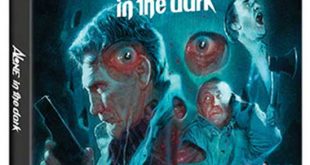
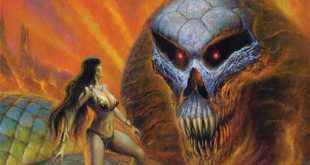

Great list, but you’re missing the Bone Collector, Striking Distance, Copycat, Fear, Eye See You, Night Game and the whole Relentless series. And although it is actually an action movie, Con Air contains a good number of serial killers in it (Cyrus the Virus, Johnny 23, the Marietta Mangler.)
Thanks for reading! You’re absolutely correct, there’s a lot of gaps, and the gaps are getting bigger since I originally compiled this list in March 2012. In my defense, I did put a disclaimer at the top of the article: “It is not intended to be a complete list nor terribly insightful, but a simple rundown of the best, worst and most interesting serial killer titles to be found.”
Also check out The Clovehitch Killer from 2018. Rather formidable entry.